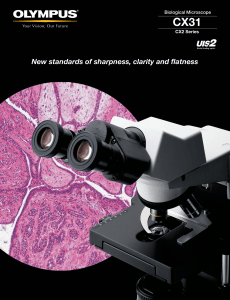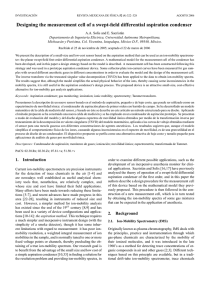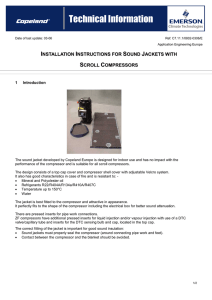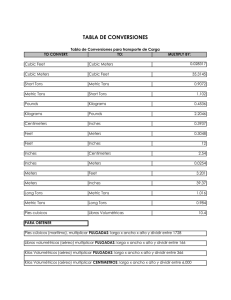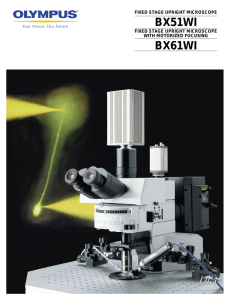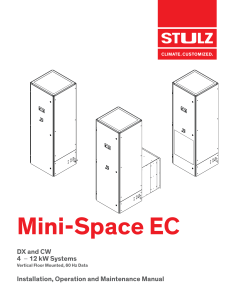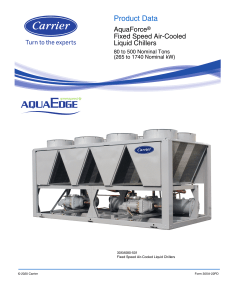Air-Cooled Condensers
Anuncio
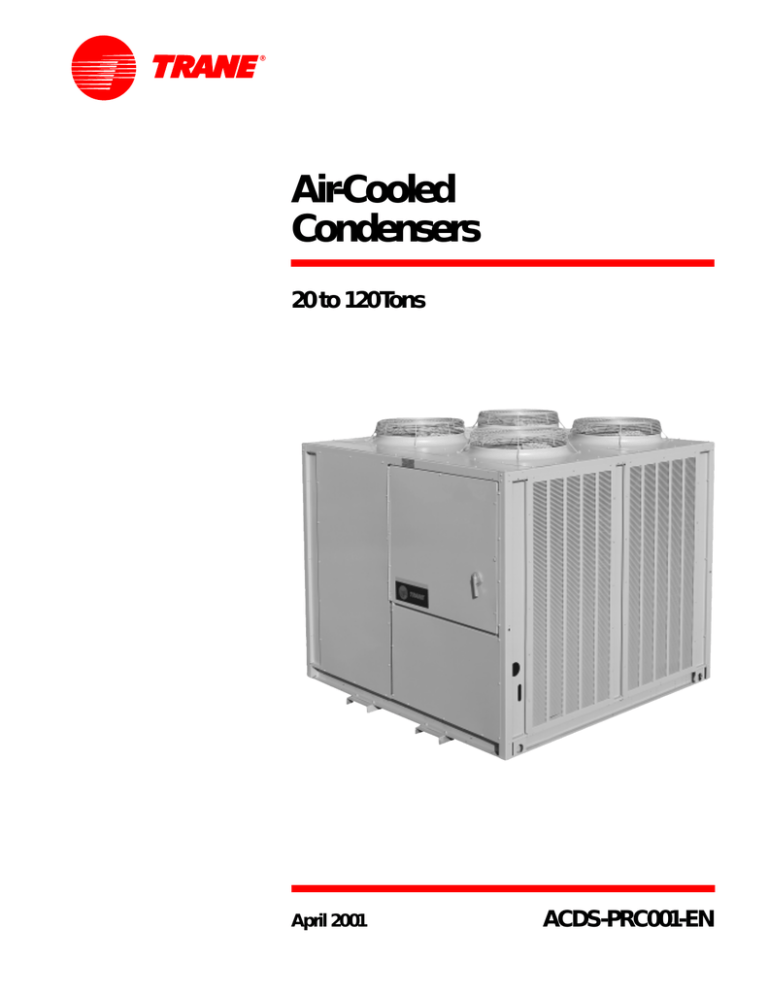
Air-Cooled Condensers 20 to 120Tons April 2001 ACDS-PRC001-EN Introduction Air-Cooled Condensers Built for Every Need Trane has the right condenser...If you are designing a new system or replacing an existing air-cooled condenser,Trane can satisfy virtually any application need. Whether coupled with an industrial compressor, a single zone commercial self-contained unit, compressor chiller or a Cold Generator® chiller,Trane has the right air-cooled condenser for the job. When teamed with any one of a ©American Standard Inc. 2001 wide range of compressor-evaporator combinations,Trane air-cooled condensers, available in 20 to 120 tons, are ideal for multistory office buildings, hotels, schools, municipal and industrial facilities. ACDS-PRC001-EN Contents Introduction Features and Benefits 2 Application Considerations 5 Selection Procedure 6 4 Model Number Description 8 9 General Data Performance Data 11 Performance Adjustment Factors ACDS-PRC001-EN Electric Power 10 12 Dimension and Weights 13 Mechanical Specifications 23 3 Features and Benefits 20 to 120 Ton Units Trane 20 to 120 ton air-cooled condensers have an operating range of 40 F to 115 F, with a low ambient option down to 0 F. The control panel is factory-installed and wired to prevent potential damage and to provide weathertight protection. The control panel contains: • fan motor contactors. • fan cycling controls. • terminal point connection for compressor interlock. • 115-volt control power transformer. These standard features reduce installation costs and provide easy interface with control logic. AllTrane air-cooled condenser coils are tube-in-sheet construction with copper tubing mechanically bonded to configurated aluminum fins. 20 to 30 ton condensers are single circuit; 40 to 120 ton units are dual circuited; all feature integral subcooling. Copper coils are optional. Durable Construction Trane 20 to 120 ton condensers are built for long life. The unit frame is constructed of 14 gauge galvanized steel. Louvered panels provide excellent coil protection while enhancing unit appearance and strength. The unit surface is phosphatized and finished withTrane Slate Grey air-dry paint. This air drypaint finish exceeds 500 consecutive hour salt spray resistance in accordance with ASTM B117. Application Considerations Certain application constraints should be considered when sizing, selecting, and installing air-cooled condensers. Unit and system reliability depends on properly and completely acknowledging these considerations. Consult your local Trane sales engineer if your application varies from these guidelines. reduce sound transmitted through electrical conduit. Setting the Unit Servicing A base or foundation is not required if the selected unit location is level and strong enough to support the operating weight. Refer to the Weights section for the weight of individual units. Recommended minimum space envelopes for servicing are located in the Dimensional Data section and serve as guidelines for providing adequate clearance. The minimum space envelopes also allow for control panel door swing and routine maintenance requirements. Isolation and Sound Emission The most effective method of noise isolation is proper unit location. Units should be placed away from noise sensitive areas. Structurally transmitted noise can be reduced with the use of spring isolators and they are recommended for acoustically sensitive applications. Flexible electrical conduit, for maximum isolation effectiveness, will 4 State and local codes on sound emissions should always be considered. Since the environment in which a sound source is located affects sound pressure, unit placement must be carefully evaluated. ACDS-PRC001-EN Application Considerations Unit Location Clearance Ambient Limitations Unobstructed flow of condenser air is essential to maintaining capacity and operating efficiency. When determining unit placement, careful consideration must be given to assure a sufficient flow of air across the condenser heat transfer surface. Two detrimental conditions are possible and must be avoided: Warm air recirculation and coil starvation. Vertical condenser air discharge must be unobstructed. While it is difficult to predict the degree of warm air recirculation, a unit installed with a ceiling or other obstruction above it will lose capacity and the maximum ambient operation will be reduced. Nuisance high head pressure tripouts may also occur. Trane condensers are designed for yeararound applications in ambients from 0 F through 115 F. For operation below 0 F or above 115 F, contact the localTrane sales office. Warm air recirculation occurs when discharge air from the condenser fans is recycled back at the condenser coil inlet. Coil starvation occurs when free airflow to the condenser is restricted. The inlet to the coil must also be unobstructed. A unit installed closer than the minimum recommended distance to a wall or other vertical riser may experience a combination of coil starvation and warm air recirculation, resulting in unit capacity and efficiency reductions, as well as possible excessive head pressures. The recommended lateral distances are listed in the Dimensional Data section. Both warm air recirculation and coil starvation cause reductions in unit efficiency and capacity because of the higher head pressures associated with them. In more severe cases, nuisance unit shutdowns will result from excessive head pressures. Cross winds, those perpendicular to the condenser, tend to aid efficient operation in warmer ambient conditions. However, they tend to be detrimental to operation in lower ambients or when hot gas bypass is used due to the accompanying loss of adequate head pressure. As a result, it is advisable to protect air-cooled condensers from continuous direct winds exceeding 10 miles per hour. Debris, trash, supplies, etc., should not be allowed to accumulate in the vicinity of the air-cooled condenser. Supply air movement may draw debris into the condenser coil, blocking spaces between coil fins and causing coil starvation. Special consideration should be given to low ambient units. Condenser coils and fan discharge must be kept free of snow or other obstructions to permit adequate airflow for satisfactory unit operation. ACDS-PRC001-EN Voltage Nominal voltage is the nameplate rating voltage. The actual range of line voltages at which the equipment can satisfactorily operate is given below: Nominal Voltage Voltage Utilization Range 200/220 180-220 or 208-254 460 416-508 575 520-635 200/230-volt units ship from the factory set for operation in the 180 through 220volt range. By changing leads on unit transformers, the unit will operate in the 208 through 254-volt range. Start-up and operation ofTrane condensers at lower ambient temperatures require that sufficient head pressure be maintained for proper operation. Minimum operating ambient temperatures for standard unit selections and units with hot gas bypass are shown in the General Data section. These temperatures are based on still conditions (winds not exceeding five mph.) Greater wind velocities will result in a drop in head pressure, therefore, increasing the minimum starting and operating ambient temperatures. Units with the low ambient option are capable of starting and operating in ambients down to 0 F, 10 F with hot gas bypass. Optional low ambient units use a condenser fan damper arrangement that controls condenser capacity by modulating in response to head pressure. Maximum cataloged ambient temperature operation of a standard condenser is 115 F. Operation at design ambients above 115 F can result in excessive head pressures. For operation above 115 F, contact the localTrane sales office. Effects of Altitude The tables in the Performance Data section are for use at sea level. At elevations substantially above sea level, the decreased air density will decrease condenser capacity. Refer to the Performance Adjustment Factors section to correct performance at other altitudes. 5 Selection Procedures c Example: At 95 F ambient and 129.4 F condensing temperature there is a 10.1% increase in capacity due to subcooling. This yields a system net capacity of 93.8 tons x 110% = 103.2 tons. Determine the total cooling load and the evaporator sst and compressor required. Transfer the results from the compressor and condenser plots to Chart SP-1 and do the following. Draw a line through the two points representing gross heat compressor capacities less subcooling (105.6 and 82.3). Draw a line through the two points representing condenser gross heat of rejection (55.4 and 82.3). Example: d Given –Total cooling load = 96 tons – Ambient temp = 95 F – Evaporator sst = 45 F – Compressor – CUAB-D10E At the point of intersection of the compressor and condenser lines draw dashed lines to the left and bottom margins of Chart SP-1. The end points of these lines will show a resultant gross condenser capacity of 93.8 tons at 129.4 F condensing temperature. When selecting a combination of equipment, it becomes necessary to match the compressor and condenser performance. The following procedure should be used in determining the correct condenser. First: The compressor was selected from COM-DS-1 catalog according to the sst and maximum acceptable condensing temperature for adequate compressor capacity. a e From chart PD-2 calculate the percent increase in capacity due to subcooling. f If necessary use the values inTable PD-4 to adjust the system capacity for altitude. g Compare this result with the design capacity and condensing temperature. The required cooling load is 96 tons, therefore, the CAUC-D10 is the proper selection. Repeat the process steps B through G as necessary to achieve the most economic condenser selection. Plot at least two gross compressor capacities (less subcooling) at the design suction temperature and different condensing temperatures. (subcooling factor is .047% per deg. F subcooling, 16 F for CUAB-D10E) Example: (From COM-DS-1) CUAB-D10E Compressor at 45 F sst. With: 115 F condensing temperature = 113.5 tons divided by 1.075 subcooling factor = 105.6 tons. With: 125 F condensing temperature = 105.1 tons divided by 1.075 subcooling factor = 97.8 tons b Plot two gross condenser heat rejection points on chart PD-1 divided by the compressor N factor (Table PD-1 to PD-3) at different condensing temperatures. Example: Anticipating 100 ton condenser to meet design load of 96 tons. Gross Heat of Rejection Cond. Temp ITD (MBh) = 115 125 6 at at 20 30 = = 830 1285 = = Tons ÷ N Factor = Tons 69.2 107.1 ÷ ÷ 1.25* 1.30* = = 55.4 82.3 *N factor corrected from Table PD-2 sst – saturated suction temperature F – degree Fahrenheit N – compressor factor ITD – initial temperature difference ACDS-PRC001-EN Selection Example Chart SP-1 — Selection Example ACDS-PRC001-EN 7 Model Number Description 20 To 60Ton Model Nomenclature C A U 1 2 3 C C20 4 1 * 4 5,6,7 8 9 10 Digit 1 — Unit Type Digit 4 — Development Sequence C = Condenser C = Third Digit 2 — Condenser Digit s 5,6,7 — Nominal Capacity A = Air-Cooled C20 = 20Tons C25 = 25Tons C30 = 30Tons Digit 3 — Airflow U = Upflow C40 = 40Tons C50 = 50Tons C60 = 60Tons Digit 8 — Power Supply G = 200/230/60/3 XL 4 = 460/60/3 XL 5 = 575/60/3 XL 0 3 H 01 11 12 13 14 Digit 11 — Ambient Control 0 = Standard 1 = 0F Digit 12 — Agency Approval 0 = None 3 = UL/CSA Digits 13, 14 — Miscellaneous H = Copper Fins 1 = Spring Isolators 2 = Rubber Isolators Digit 9 — Condenser Circuit 1 = Single (20-30 Ton) 2 = Dual (40-60 Ton) Digit 10 — Design Sequence * = Factory Assigned 80 To 120 Ton Model Nomenclature C A U 1 2 3 C C80 4 2 A 4 5,6,7 8 9 10 Digit 1 — Unit Type C = Condenser Digit 4 — Development Sequence C = Third Digit 2 — Condenser A = Air-Cooled Digits 5,6,7 — Nominal Capacity C80 = 80 Tons D10 = 100 Tons D12 = 120 Tons Digit 3 — Airflow U = Upflow Digit 8 — Power Supply F = 230/60/3 4 = 460/60/3 5 = 575/60/3 E = 200/60/3 0 3 H 01 11 12 13 14 Digit 11 — Ambient Control 0 = Standard 1 = 0F Digit 12 — Agency Approval 0 = None 2 = CSA 3 = UL/CSA Digits 13, 14 — Miscellaneous H = Copper Fins 1 = Spring Isolators Digit 9 — Condenser Circuit 2 = Dual Circuit Digit 10 — Design Sequence A = First 1. The service digit for each model number contains 14 digits; all 14 digits must be referenced. 8 ACDS-PRC001-EN General Data Table GD-1 — General Data 20 Ton Model Number CAUC-C20 Gross Heat Rejection (MBh)1 301 Condenser Fan Data Number/Size/Type 2/26”/Prop Fan Drive Direct No. of Motors/Hp (Each) 2/1.0 Nominal Cfm 12,400 Condenser Coil Data No./Size (In.) 1/63x71 Face Area (Sq. Ft.) 31.0 Rows/Fins Per Ft. 3/168 General Data No. Refrigerant Circuits 1 Operating Charge2 (Lbs of R-22) 25 Condenser Storage Capacity3 67 Ambient Temperature Operating Range Standard Ambient (F) 40-115 Low Ambient Option (F) 0-115 25 Ton CAUC-C25 373 30 Ton CAUC-C30 455 40 Ton CAUC-C40 614 50 Ton CAUC-C50 712 60 Ton CAUC-C60 888 80 Ton CAUC-C80 1244 100Ton CAUC-D10 1425 120 Ton CAUC-D12 1819 3/26”/Prop Direct 3/1.0 16,700 3/26”/Prop Direct 3/1.0 19,000 4/26”/Prop Direct 4/1.0 24,800 6/26”/Prop Direct 6/1.0 33,400 6/26”/Prop Direct 6/1.0 38,000 8/26”/Prop 12/26”/Prop 12/26”/Prop Direct Direct Direct 8/1.0 12/1.0 12/1.0 49,600 66,800 76,000 1/71x71 2/65x70 2/51x96 2/66x90 4/65x70 4/51x96 4/66x90 35.0 3/156 1/45x71 1/49x71 46.1 3/168 63.2 3/168 67.1 3/156 88.0 3/168 126.4 3/168 136.0 3/156 165.0 3/168 1 28 76 1 37 96 2 52 136 2 56 142 2 74 184 2 104 272 2 112 284 2 148 368 40-115 0-115 40-115 0-115 40-115 0-115 40-115 0-115 40-115 0-115 40-115 0-115 40-115 0-115 40-115 0-115 Notes: 1. Gross Heat Rejection is at a 30 F ITD (Intial Temperature Difference) between condensing temperature and ambient air entering condenser (includes the effect of subcooling). 2. Operating charge is for entire unit. 3. At conditions of 95 F ambient, condenser is 95 percent full. ACDS-PRC001-EN 9 Performance Adjustment Factors Chart PD-2— Compressor-Condenser Capacity Increase Due To Subcooling (R-22) Table PD-1 – - N Factor – - Semihermetic Compressors Saturated Suction Temperature (F) Cond. Temp. 110 115 120 125 130 135 140 145 30 1.34 1.36 1.40 1.43 1.48 1.52 1.58 1.65 35 1.32 1.34 1.37 1.40 1.44 1.48 1.54 1.59 40 1.29 1.31 1.34 1.37 1.40 1.44 1.49 1.54 45 1.27 1.29 1.32 1.34 1.38 1.41 1.45 1.49 50 1.25 1.27 1.30 1.32 1.35 1.38 1.42 1.46 Note: 1. In order to determine N factor for CUAB units, find proper factor corresponding with the proper suction and condensing temperature from Table 9-1. This factor should be adjusted by adding or subtracting the correction value from Table 9-2. Table PD-4 – - N Factor Correction – - Compressor Table PD-2– - N Factor – - Open Compressors Saturated Suction Temperature (F) Cond. Temp. 110 115 120 125 130 135 140 30 1.245 1.260 1.275 1.290 1.305 1.320 1.335 35 1.225 1.240 1.255 1.270 1.285 1.300 1.315 40 1.215 1.230 1.245 1.260 1.275 1.290 1.305 45 1.195 1.210 1.225 1.240 1.255 1.270 1.285 50 1.175 1.190 1.205 1.220 1.235 1.250 1.265 Compressor CUAB-015M 020M 025M 030M 040R 050R 060R 075E 100E Correction Factor + 0.02 ––– – 0.01 + 0.01 – 0.02 – 0.04 – 0.04 – 0.02 – 0.04 Table PD-3 – - Altitude Correction Multiplier For Cooling Capacity – - Air-Cooled Condenser Altitude (Ft) Correction Multiplier 10 2,000 0.977 4,000 0.949 6,000 0.917 8,000 0.881 10,000 0.843 ACDS-PRC001-EN Performance Data Chart PD-1 — Condenser Heat Rejection (R-22), 20-120 Ton ACDS-PRC001-EN 11 Electrical Data Table ED-1 — Electrical Data Unit Characteristics Nominal Tons 20 25 30 40 50 60 80 100 120 Condenser Fan Motor Model No. CAUC-C20G CAUC-C204 Electrical Characteristics 200-230/60/3 460/60/3 Allowable Voltage Range 180-220/208-254 416-508 Minimum Circuit Ampacity (3),(5) 9.2 4.1 Maximum Fuse Size (2),(5) 15 15 No./HP (1) 2/1.0 2/1.0 FLA (Ea.) (1) 4.1 1.8 CAUC-C205 CAUC-C25G CAUC-C254 CAUC-C255 CAUC-C30G CAUC-C304 CAUC-C305 575/60/3 200-230/60/3 460/60/3 575/60/3 200-230/60/3 460/60/3 575/60/3 520-635 180-220/208-254 416-508 520-635 180-220/208-254 416-508 520-635 3.2 13.3 5.9 4.6 13.3 5.9 4.6 15 20 15 15 20 15 15 2/1.0 3/1.0 3/1.0 3/1.0 3/1.0 3/1.0 3/1.0 1.4 4.1 1.8 1.4 4.1 1.8 1.4 7.2 20.7 9.0 7.2 20.7 9.0 7.2 0.9 0.9 0.9 0.9 0.9 0.9 0.9 CAUC-C40G CAUC-C404 CAUC-C405 CAUC-C50G CAUC-C504 CAUC-C505 200-230/60/3 460/60/3 575/60/3 200-230/60/3 460/60/3 575/60/3 180-220/208-254 416-508 520-635 180-220/208-254 416-508 520-635 17.4 7.7 6.0 25.6 11.3 8.8 20 15 15 30 15 15 4/1.0 4/1.0 4/1.0 6/1.0 6/1.0 6/1.0 4.1 1.8 1.4 4.1 1.8 1.4 20.7 9.0 7.2 20.7 9.0 7.2 0.9 0.9 0.9 0.9 0.9 0.9 CAUC-C60G CAUC-C604 CAUC-C605 200-230/60/3 460/60/3 575/60/3 180-220/208-254 416-508 520-635 25.6 11.3 8.8 30 15 15 6/1.0 6/1.0 6/1.0 4.1 1.8 1.4 20.7 9.0 7.2 0.9 0.9 0.9 CAUC-C80E CAUC-C80F CAUC-C804 CAUC-C805 200/60/3 230/60/3 460/60/3 575/60/3 180-220 208-254 416-508 520-635 34 34 15 12 40 40 20 15 8/1.0 8/1.0 8/1.0 8/1.0 4.1 4.1 1.8 1.4 20.7 20.7 9.0 7.2 0.9 0.9 0.9 0.9 CAUC-D10E CAUC-D10F CAUC-D104 CAUC-D105 200/60/3 230/60/3 460/60/3 575/60/3 180-220 208-254 416-508 520-635 50 50 22 17 60 60 25 20 12/1.0 12/1.0 12/1.0 12/1.0 4.1 4.1 1.8 1.4 20.7 20.7 9.0 7.2 0.9 0.9 0.9 0.9 CAUC-D12E CAUC-D12F CAUC-D124 CAUC-D125 200/60/3 230/60/3 460/60/3 575/60/3 180-220 208-254 416-508 520-635 50 50 22 17 60 60 25 20 12/1.0 12/1.01 12/1.0 12/1.0 4.1 4.1 1.8 1.4 20.7 20.7 9.0 7.2 0.9 0.9 0.9 0.9 LRA (Ea.) (1) 20.7 9.0 KW (Ea.) (1),(4) 0.9 0.9 Notes: 1. Electric information is for each individual motor. 2. Maximum fuse size is permitted by NEC 440-22 is 300 percent of one motor RLA plus the RLA of the remaining motors. 3. Minimum circuit ampacity equals 125 percent of the RLA of one motor plus the RLA of the remaining motors. 4. All Kw values taken at conditions of 45 F saturated suction temperature at the compressor and 95 F ambient. 5. Local codes may take precedence. 12 ACDS-PRC001-EN Dimensional Data (20 Ton) Figure DD-1 — CAUC-C20 Unit Dimensions, Recommended Clearances, Mounting Locations, Electric and Refrigerant Connection Sizes and Locations ACDS-PRC001-EN 13 Dimensional Data (25Ton) Figure DD-2 — CAUC-C25 Unit Dimensions, Recommended Clearances, Mounting Locations, Electric and Refrigerant Connection Sizes and Locations 14 ACDS-PRC001-EN Dimensional Data (30 Ton) Figure DD-3 — CAUC-C30 Unit Dimensions, Recommended Clearances, Mounting Locations, Electric and Refrigerant Connection Sizes and Locations ACDS-PRC001-EN 15 Dimensional Data (40Ton) Figure DD-4 — CAUC-C40 Unit Dimensions, Recommended Clearances, Mounting Locations, Electric and Refrigerant Connection Sizes and Locations 16 ACDS-PRC001-EN Dimensional Data (50 Ton) Figure DD-5 — CAUC-C50 Unit Dimensions, Recommended Clearances, Mounting Locations, Electric and Refrigerant Connection Sizes and Locations ACDS-PRC001-EN 17 Dimensional Data (60Ton) Figure DD-6 — CAUC-C60 Unit Dimensions, Recommended Clearances, Mounting Locations, Electric and Refrigerant Connection Sizes and Locations 18 ACDS-PRC001-EN Dimensional Data (80 Ton) Figure DD-7 — CAUC-C80 Unit Dimensions, Recommended Clearances, Mounting Locations, Electric and Refrigerant Connection Sizes and Locations ACDS-PRC001-EN 19 Dimensional Data (100 Ton) Figure DD-9 — CAUC-C100 Unit Dimensions, Recommended Clearances, Mounting Locations, Electric and Refrigerant Connection Sizes and Locations 20 ACDS-PRC001-EN Dimensional Data (120 Ton) Figure DD-10 — CAUC-C120 Unit Dimensions, Recommended Clearances, Mounting Locations, Electric and Refrigerant Connection Sizes and Locations ACDS-PRC001-EN 21 Weights Figure W-1 — 20-30 Tons Figure W-2 — 40-60 Tons Top View (Mounting Locations) Table W-1 — 20 to 60 Ton Weights (Lbs./Kg.) Nominal Tons 20 25 30 40 50 60 Operating Model Weight Number AL CU CAUC-C20 Lb. 1146 1348 Kg. 519.8 611.5 CAUC-C25 Lb. 1190 1394 Kg. 539.8 632.3 CAUC-C30 Lb. 1302 1585 Kg. 590.6 719.0 CAUC-C40 Lb. 2048 2366 Kg. 929.0 1073.2 CAUC-C50 Lb. 2280 2664 Kg. 1034.2 1208.4 CAUC-C60 Lb. 2465 3010 Kg. 1118.1 1365.3 Loc. 1 AL CU 320 371 145.2 168.3 329 378 149.2 171.5 353 414 160.1 187.8 363 406 164.7 184.2 407 464 184.6 210.5 433 515 196.4 233.6 Loc. 2 AL CU 326 365 147.9 165.6 337 381 152.9 172.8 371 444 168.3 201.4 347 392 157.4 177.8 392 449 177.8 203.7 420 505 190.5 229.1 Weight On Isolator At Mounting Locations Loc. 3 Loc. 4 AL CU AL CU 248 306 252 301 112.5 138.8 114.3 136.5 259 315 265 319 117.5 142.9 120.2 144.7 282 355 296 381 127.9 161.0 134.3 172.8 349 404 334 389 158.3 183.3 151.5 176.5 387 453 373 438 175.5 205.5 169.2 198.7 417 511 405 501 189.2 231.8 183.7 227.3 Loc. 5 Loc. 6 AL –– CU –– AL –– CU –– –– –– –– –– –– –– –– –– 335 152.0 367 166.5 401 181.9 401 181.9 441 200.0 507 230.0 320 145.2 354 160.6 389 176.5 387 175.5 427 193.7 497 225.4 Figure W-3 — 80-120 Tons Top View (Mounting Locations) Table W-2 — 80 to 120 Ton Weights (Lbs./Kg.) Nominal Tons 80 Model Number Coil Fin AL CAUC-C80 CU AL 100 CAUC-D10 CU AL 120 CAUC-D12 CU 22 Lb. Kg. Lb. Kg. Lb. Kg. Lb. Kg. Lb. Kg. Lb. Kg. Operating Weight 4036 1830.7 4542 2060.3 4911 2227.6 5371 2436.3 5472 2482.1 5971 2708.4 Loc. 1 514 233.2 603 273.5 631 286.2 586 265.8 698 316.6 774 351.1 Loc. 2 478 216.8 571 259.0 600 272.2 549 249.0 666 302.1 742 336.6 Weight On Isolator At Mounting Points Loc. 3 Loc. 4 Loc. 5 Loc. 6 522 485 524 487 236.8 220.0 237.7 220.9 600 569 600 568 272.2 258.1 272.2 257.6 630 598 629 598 285.8 271.3 285.3 271.3 597 560 600 562 270.8 254.0 272.2 254.9 700 668 700 668 317.5 303.0 317.5 303.0 779 747 780 748 353.4 338.8 353.8 339.3 Loc.7 532 241.3 597 270.8 628 284.9 611 277.1 702 318.4 786 356.5 Loc.8 494 224.1 566 256.7 597 270.8 572 259.5 670 303.9 753 341.6 ACDS-PRC001-EN Mechanical Specifications General Factory-assembled and wired air cooled condensing unit. Units are constructed of 14-gauge welded galvanized steel frame with 14 and 16-gauge galvanized steel panels and access doors. Unit surface is phosphatized and finished with an air-dry paint.This air-dry paint finish is durable enough to withstand a 1000-consecutive-hour salt spray application in accordance with standard ASTM B117. Refrigeration Circuits and Control The 20 to 30 ton units are single circuit. The 40 to 120 ton units are dual circuited. All the necessary controls to run the unit fans are provided. The control panel contains fan motor contactors, terminal point connection for compressor interlock and 115 volt control power transformer. Standard units will operate from 40 to 115 F. All units shipped with factory installed liquid line service valves. Condenser Coils and Fans Condenser coils have configurated aluminum fins mechanically bonded to copper tubing with integral subcooler. The coils are underwater burst/leak tested at 450 psi. Direct drive condenser fan motors have permanently lubricated ball bearings and thermal overload protection. Low Ambient Operation Standard ambient control allows operation down to 40 F with cycling of condenser fans. Optional low ambient allows operation down to 0 F with external damper assembly for head pressure control. Refer to Options section for details. head pressure control dampers. The control consists of a heavy gauge damper assembly, R-22 operator, tubing and grommet. All components are factory-mounted for both production and Packed Stock Plus units. Low ambient control must be ordered when the air-cooled condenser is matched with a CCKC heat recovery chiller. Copper Finned Condenser Coil Copper fins are mechanically bonded to copper tubes for use in corrosive atmospheres. Nominal unit capacity remains the same. Spring Isolation Package Spring isolators reduce transmission of noise and vibration to building structure, equipment, and adjacent spaces. Isolators consist of a cast, spring loaded, telescoping housing as the isolation medium. Mountings include built-in leveling bolts, resilient inserts that act as centering guides, and ribbed neoprene acoustical pads bonded to the bottom of the isolator. The kit includes instructions for field installation. Neoprene-in-shear Isolation Package Neoprene isolators reduce transmission of noise and vibration to building structure, equipment, and adjacent spaces. Isolators have a steel plate and base completely imbedded in neoprene. Mountings have a 1/4-inch deflection. The kit includes instructions for field installation. Available on 20 to 60-ton units only. Options Low Ambient Control Low ambient allows operation down to 0 F through the use of fan cycling and ACDS-PRC001-EN 23 Literature Order Number Trane A business of American Standard Companies www.trane.com For more information contact your local district office, or e-mail us at [email protected] ACDS-PRC001-EN File Number PL-RF-ACDS-PRC0001-EN-04-2001 Supersedes ACDS-DS-1 07/00 Stocking Location Webb/Mason Trane has a policy of continuous product and product data improvement and reserves the right to change design and specifications without notice.
